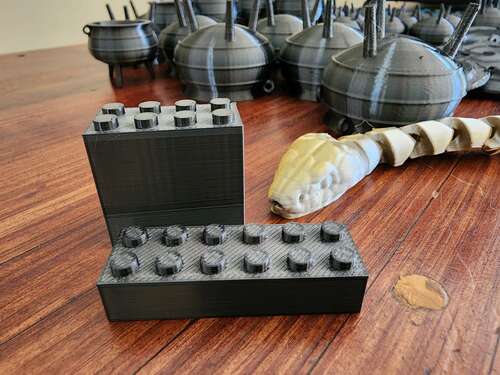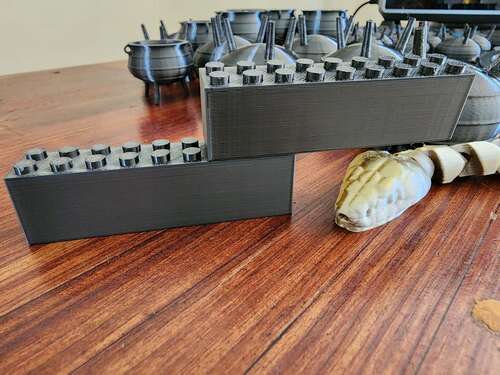Key Takeaways
- LEGO’s patents have expired, which makes it legal to make compatible bricks that don’t infringe on LEGO trademarks.
- You can find brick model files online to 3D print.
- Printed LEGO bricks may not fit perfectly, but are still usable for building your own projects.
Proper LEGO is expensive, and sometimes you just need a specific brick or a brick that no one makes anymore. So what about simply 3D printing LEGO? I took a shot at it, and it’s not as simple as I thought.
The Great LEGO Patent Expiration and “Compatible” Bricks
Before we get onto my mini LEGO-printing adventure, it is worth covering why this is even possible from a legal standpoint. You’ve probably noticed that there are plenty of LEGO “compatible” bricks on the market, and the Danish toy company doesn’t seem to be doing anything about it. The fact is that the patents covering the locking mechanism of LEGO bricks have expired. So, while the LEGO trademark is protected, there’s nothing illegal about making bricks that are compatible with genuine LEGO.
Not that LEGO let this happen without a fight, its failed legal battles with companies like Mega Blocks make for fascinating reading. For our purposes here, all you need to know is that regular folks making LEGO models for 3D printing is fine, as long as they don’t pretend to be real LEGO or use the company’s trademarks.
Where to Find Brick Model Files
If you have the talent and the time, nothing’s stopping you from firing up your favorite CAD program and whipping up your own LEGO, but luckily plenty of people have already done the hard work for us. In this case I used FaronMentink’s LEGO compatible bricks found on Thingiverse, but if those don’t work for you, there are numerous other options on Thingiverse and other websites that host files for 3D printing.
Printer, Setup, Material, & Settings
For my test I used a Creality K1 Max, which is Creality’s flagship next-generation 3D printer. I printed it at both 0.2mm and 0.1mm resolutions to see if there was a resolution threshold, and I used the high quality preset for this printer in particular, without tweaking. The material I used is PLA. While real LEGO is injection-molded using ABS plastic, I don’t really work with ABS and many people who print their own bricks use PLA, which isn’t as UV sensitive and doesn’t have the toxicity issues that ABS does. As always, you can choose whichever material you like and that’s compatible with your printer. Results are likely to vary slightly depending on the properties of each material.
As far as possible, I try to avoid using supports for my prints, because they leave markers on the model that require cleaning later. So I’ve printed these bricks in place, right-way-up to ensure there are no overhangs that would fail. However, some more exotic brick types might need supports, which you’ll have to generate using your 3D printing software.
The Results
My first attempt at printing a few test bricks did not go well. The K1 uses a smooth print bed out of the box, and you’re supposed to rub a glue stick all over it before printing to help with adhesion. As a rule, I have not found this necessary, and so I can dispense with the messy cleanup and just get on with printing. Not so for my poor bricks, which very much did not remain stuck to the bed, and the print had to be abandoned. Two bricks did make it, giving me viable 0.2mm standard quality samples.
My second print, with glue properly applied, went through without a hitch. I used black satin PLA, and although the layer lines are apparent, overall the bricks look pretty good!
Testing Compatibility With Real LEGO
While the blocks I printed certainly looked the part, unfortunately they simply did not work correctly. While they fit real LEGO pieces and each other, the tolerance were simply too loose. With some specific blocks, I could get a good fit, but there’s no denying how precise injection-molded blocks like those made by LEGO are.
OK, not the end of the world. At least you’d expect the bricks you printed to work with each other, but sadly that wasn’t the case either. For my printer, and my materials, these bricks just weren’t working. So I had to look for an alternative set of models and came upon Cfinke’s customizable LEGO-compatible bricks.
After printing out two test blocks, I got a pretty decent fit with real LEGO, but an incredible fit between the 3D-printed blocks themselves. In fact, they may be a little too tight-fitting because them to come apart is much harder than with real LEGO. I can however, see myself printing out enough bricks to complete a build using this particular set, knowing that it won’t fall apart.
The Printed LEGO Rabbit Hole
This was just some initial dabbling after I wondered how close I could get to real LEGO with the equipment I have. Filament is after all cheap, so if you have the patience you could print out bricks that would cost hundreds or even thousands of Dollars. However, there’s no denying that the precise injection-molded method of making these bricks is still far superior when you need every brick to come out exactly the same, and the tolerances have to be just right.
At some point, consumer-grade 3D printers might be able to match the quality of factory made bricks from companies like LEGO or one of their competitors. but for now it’s mainly a fun thing you can do as a 3D printing hobbyist.



